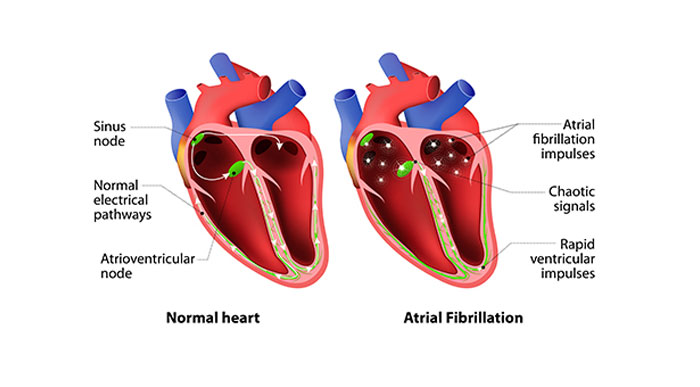
Cardiac Arrhythmias
What is cardiac arrhythmia?
The term arrhythmia means disturbance in cardiac rhythm. It is of grossly two types: brady-arrhythmia and tachy-arrhythmia; i.e., one in which the heart rate is slow and the other where the heart rhythm is fast. Sometimes the heart rhythm is neither fast nor slow, but it is irregular.
How does patients with cardiac arrhythmias present?
In brady-arrhythmias, the patient can present with sudden episodes of loss of consciousness or easy fatiguability. Sometimes, though rarely, the patient may be completely asymptomatic and is diagnosed incidentally. Some severe brady-arrhythmias can cause sudden death also.
In case of tachy-arrhythmias, symptoms depend upon the heart rate and from where the heart rhythm is generated. Some benign tachy-arrhythmias, which we grossly term as PSVT, patients complain of episodes of sudden palpitation. They sometime terminate on its own, or sometimes require some injections in emergency to terminate.

On the other hand, some tachy-arrhythmias are life threatening where the heart rate suddenly goes too fast and patient can suddenly die out of this. Here immediate medical intervention including DC shock is required at times.
Now let us come to atrial fibrillation., where the heart rhythm is irregular and is originating from an abnormal circuit. Sometimes the heart rate is fast, rarely too fast to control and patient becomes symptomatic and unstable. Again, at times the rhythm is irregular but rate is within normal limit and patient may be completely asymptomatic.
How to treat these patients?
It depends upon the arrhythmia and patient status. In PSVT, we normally do some bedside maneuvers, and if not, successful we give some injections which terminate the tachycardia. We keep these patients on some oral drugs, and in case of frequent events, we need to do Electrophysiological study and Radiofrequency ablation.
In case of ventricular tachycardias, patients are generally unstable, and we need to give shock and give some injectable drugs followed by oral drugs. Some of these cases are due to acute heart attack where urgent coronary angiogram and revascularization is required. Some times they are due to weak heart, where we implant a device termed ICD (Implantable Cardiac Defibrillator). Some times we go for Electrophysiological study (mostly 3D) and ablation. Sometimes they are due to some congenital genetic diseases, where ICD may be required if proper indication is fulfilled.
In case of brady-arrhythmias with symptomatic patient we need pacemaker implantation. In asymptomatic patients 24-hourHolter or longer External Loop Recorder or much longer Implantable Loop Recorder may be required to demonstrate proper pause and then go for pacemaker implantation. Electrophysiological study is rarely required in these patients.
In case of atrial fibrillation, we can treat the patient in two ways- rate control and rhythm control. In rate control strategy we give rate controlling drugs and appropriate blood thinner as there is a chance of clot formation in heart leading to brain stroke. On the other hand, in rhythm control strategy we give the patient either some drugs or DC shock with lower voltage to terminate the arrhythmia and to restore the normal rhythm.
In the context of Siliguri, where healthcare dynamics may differ, it is essential to consider the local factors influencing the prevalence and management of cardiac arrhythmias. Access to specialized care, community awareness, and timely interventions become crucial elements in ensuring optimal outcomes for individuals grappling with these rhythm disturbances.
By understanding the unique challenges posed by cardiac arrhythmias in Siliguri, healthcare professionals can tailor interventions, including pacemaker implantations, electrophysiological studies, and rhythm control strategies, to meet the specific needs of the local population. This localized and patient-centered approach is vital for enhancing the overall cardiac health and well-being of individuals facing arrhythmias in the Siliguri region.

